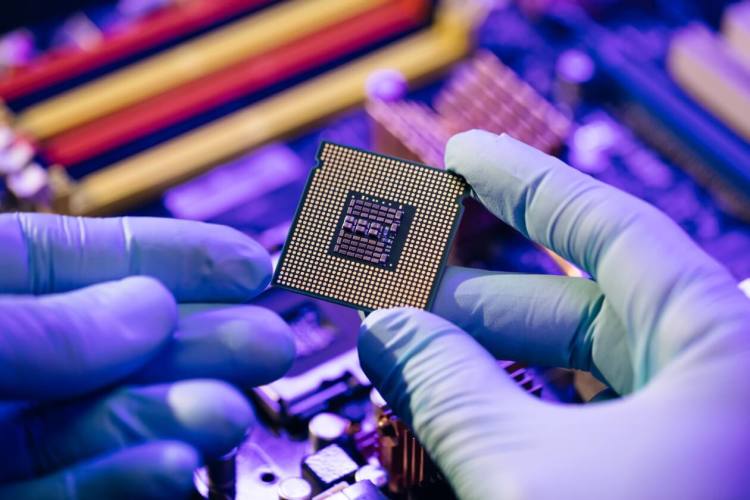Semiconductors, and the microchips they’ve been used in since the mid-20th century, might represent the biggest technological leap in living memory.
From calculators to computers, smart-phones, cloud-based data centres, self-driving cars, and recently artificial intelligence (AI), the rise in processing power underpins them all.
But it’s a big and complex ecosystem. Its components range from the raw silicon ‘wafers’ that circuits are printed on, all the way through to end-point chip manufacturers, called ‘foundries’.
There’s also integrated device manufacturers who own the process, from design to manufacturing. The final link in the chain is the appliance or original equipment manufacturers (OEMs) like Apple and Dell.
In total, the industry has a market capitalisation of over $9tn.
What are the challenges and where are the opportunities?
It’s impossible to ignore the enthusiasm that investors have been showing for all things AI recently. This is matched by a surge in demand for the high-end processors needed to deliver the computing power that’s essential for large-language models like Chat GPT to function.
But that wasn’t enough to stop an 8.2% decline in industry sales over 2023 to $526.8bn. This was caused by weak demand for consumer products in the first half of the year. Reports of disappointing sales for the likes of Apple and Tesla suggest that there could be more pain to come in some end markets.
It’s important to remember not all chips are created equal, so while demand can be booming for certain product lines, others could be hitting a trough.
Overall, we see a lot of long-term growth drivers. These include the transition to electric vehicles and autonomous driving, demand for data storage, and a continuing shift towards wireless connectivity.
Chart showing Semiconductor sector performance
But the sector’s cyclical and not for the faint hearted. While the sector has materially outperformed the wider market in the last couple of years, it’s not always been that way.
This article isn’t personal advice. If you’re not sure an investment is right for you, seek advice. Investments and any income from them will rise and fall in value, so you could get back less than you invest. Past performance is not a guide to the future.
3 share ideas
Over the next few years, we expect the build-out of infrastructure behind AI to be key for influencing industry demand. But with the efficiency and innovation benefits AI can bring to businesses only just starting to emerge, there’s no guarantee current growth rates will go on.
Because of their increasing strategic importance on the global stage, semiconductors are subject to growing geopolitical risk. Export controls on high-end chips to China have proved to be a thorny issue, directly impacting the sales of certain products.
Geopolitical tensions are also a factor threatening the semiconductor supply chain. While international efforts are underway to diversify sources of production, Taiwan’s still dominating the manufacturing of the most advanced chips. Any escalation of tensions between it and China will likely dent investor sentiment towards the sector. Other pressures on the supply chain include capacity constraints and the constant need for highly skilled talent.
Here’s three companies we think could be well placed to prosper in the current sector challenges and opportunities.
Investing in an individual company isn’t right for everyone because if that company fails, you could lose your whole investment. If you cannot afford this, investing in a single company might not be right for you. You should make sure you understand the companies you’re investing in and their specific risks. You should also make sure any shares you own are part of a diversified portfolio.
Remember, before you can trade US shares, you need to complete and return a W-8BEN form.
Applied Materials
Applied Materials provides advanced equipment to chip manufacturers and is deeply embedded in the supply chain. Revenue’s been flat in the first quarter of 2024, with a decline in system sales being offset by growth in other divisions.
One area that did see growth was the applied services division. Here we see a growth opportunity for the company to help customers deal with increasingly complex manufacturing processes.
Underlying operating profit margins are still high at close to 30%. Longer-term, the company is considered one of the best placed equipment suppliers to benefit from the increased demands on computing power that AI is driving.
That’s taken the valuation above the long run average but compared to its direct peer group, Applied Materials offers better value than most, maybe reflecting a narrower economic moat than some of its competitors. But this is relative, and we still see considerable barriers to entry into this business.
These barriers have helped the company deliver impressive profit and cash flow growth over the last few years. The Board has committed to return between 80-100% of free cash flow to shareholders over time which should underpin the modest dividend yield while leaving room for share buybacks. Although no shareholder returns are guaranteed.
A strong balance sheet means it’s also well-placed to cope with dips in the economic cycle. But one risk to be mindful of, is the ongoing enquiry by the US Department of Justice into potential breaches over export controls to China, which could result in a financial penalty.
Dell Technologies
Dell comes with an impressive record of long-term growth but has suffered from a slowdown in the demand for endpoint computing. Markets are expecting a rebound in that division, although there can be no guarantees.
However, it’s also a major player in providing servers and storage underpinning enterprise and IT infrastructure. It’s a smaller part of the business in revenue terms, but accounts for a bigger share of profits.
In fourth-quarter earnings, orders for AI optimized servers leapt almost 40% compared to the previous quarter. Dell doesn’t design its own chips but partners with best-in-class technology partners across its product range. It’s not only a provider of backend infrastructure for AI, but also integrating AI into its workstations.
Dell’s valuation has surged on the back of hopes for its AI offering, but at 15x forward earnings, expectations aren’t as demanding as others benefitting from the boom. Growth is unlikely to hit the highs of the chip designers at the heart of the AI ecosystem. But long-term guidance of 3-4% growth in annual revenue and 8% in earnings per share isn’t to be sniffed at.
Meanwhile, strong cash flows underpin a forward dividend yield of 1.6%. Dell’s targeting 10% growth per year in the dividend, and there’s potential for share buybacks too, although there can be no guarantees.
Investing in semiconductor companies carries risk, including the potential for ups and downs because of the market’s high expectations. It’s important to carefully consider these risks before making any investment decisions in the sector.
NVIDIA
NVIDIA was the pioneer of graphics processing unit (GPU chips), a key part of the accelerated computing stack that’s driving advances in AI.
It’s by far the leading player in the data centre GPU market. AI is also accelerating the company’s financial performance, with the latest quarterly results seeing triple-figure growth in revenue and profits, even with export restrictions to China. Other headwinds to keep an eye on include the ability of key manufacturing partners to keep up with demand.
But cash generation has impressed and a balance sheet boasting net cash of over $16bn should help NVIDIA stomach ups and downs and even fund innovation.
There’s a lot to be excited about. But the company’s stratospheric profit growth hasn’t gone unnoticed, it’s now one of just a handful with a market value of over $2tn.
The valuation sits near the long-term average on a forward price-to-earnings basis, which doesn’t look too demanding to us. But there’s considerable pressure to deliver against market expectations.
This article is original Hargreaves Lansdown content, published by Hargreaves Lansdown. It was correct as at the date of publication, and our views may have changed since then. Unless otherwise stated, estimates, including prospective yields, are a consensus of analyst forecasts provided by Refinitiv. These estimates aren’t a reliable indicator of future performance. Yields are variable and not guaranteed. Investments rise and fall in value so investors could make a loss.
This article is not advice or a recommendation to buy, sell or hold any investment. No view is given on the present or future value or price of any investment, and investors should form their own view on any proposed investment. This article has not been prepared in accordance with legal requirements designed to promote the independence of investment research and is considered a marketing communication. Non-independent research is not subject to FCA rules prohibiting dealing ahead of research, however HL has put controls in place (including dealing restrictions, physical and information barriers) to manage potential conflicts of interest presented by such dealing. Please see our full non-independent research disclosure for more information.








